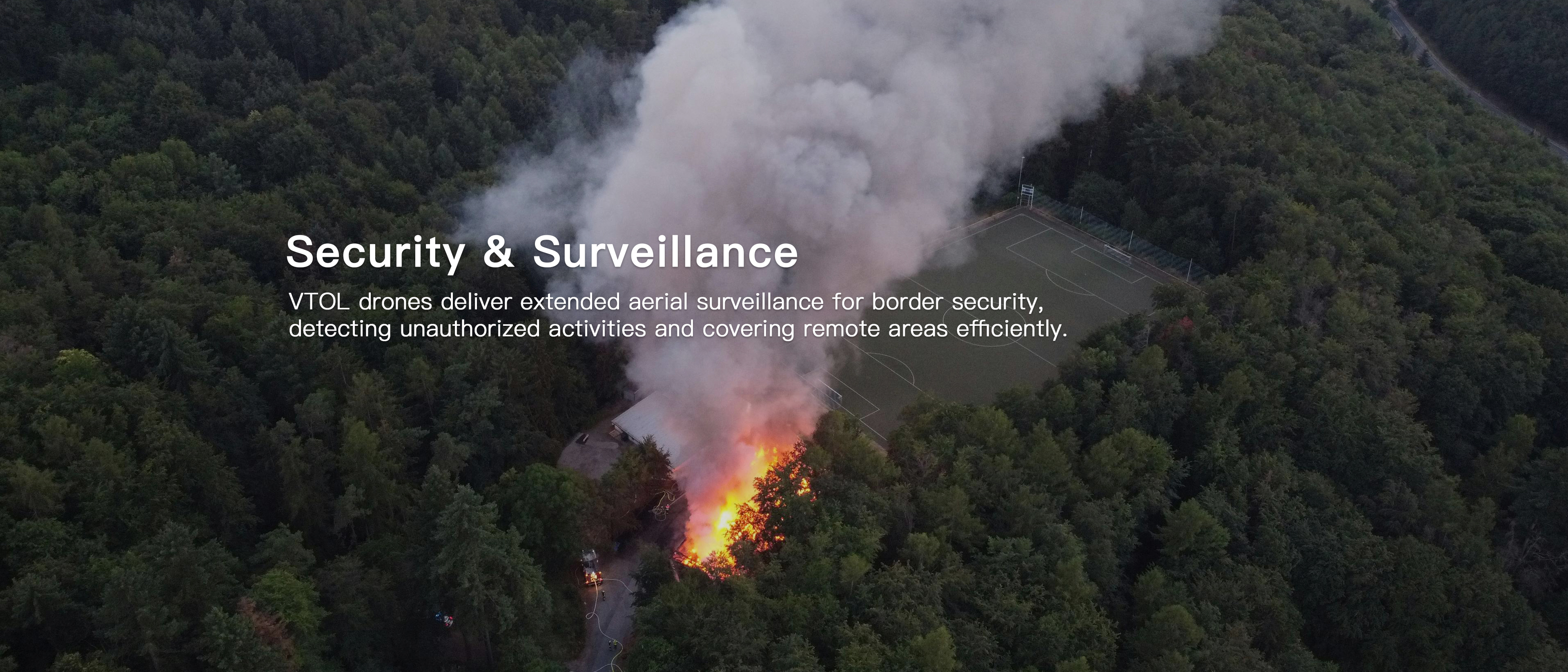
Smarter surveillance, safer perimeters, and faster response. Monitor large areas and detect threats fast without complex operations with YANGDA’s long-endurance surveillance drones equipped with gimbal camera payloads. From infrastructure to national borders, achieve uninterrupted situational awareness, night or day, in any terrain.
What Is Drone Surveillance?
Drone surveillance refers to the use of unmanned aerial vehicles (UAVs) for aerial monitoring and real-time data capture for security, monitoring, and assessment purposes. These advanced systems are equipped with high-resolution cameras and sensors, such as electro–optical (EO) and infrared (IR) gimbals, to provide detailed visuals from above. Unlike fixed CCTV cameras, drones offer flexibility and mobility that enable security teams to cover large areas more efficiently and quickly respond to possible threats.
Drone surveillance has become a necessity in various high-security and high-risk places, such as securing national borders, safeguarding industrial parks, monitoring the strength of oil and gas pipelines, or ensuring the safety of infrastructure like power plants and substations. UAVs can survey areas that are difficult or dangerous to patrol on the ground.
In urban settings, drones can help enhance crowd control by providing real-time aerial views. They prove invaluable in remote or hazardous environments, such as forest fire zones and wildlife areas. Drone cameras can detect heat signatures and track wildlife movements, providing crucial data for sound decision-making.
Drone surveillance offers real-time situational awareness. With it, response times to threats improve, such as suspicious activity around the perimeters of an area or identifying possible hazards in industrial settings.
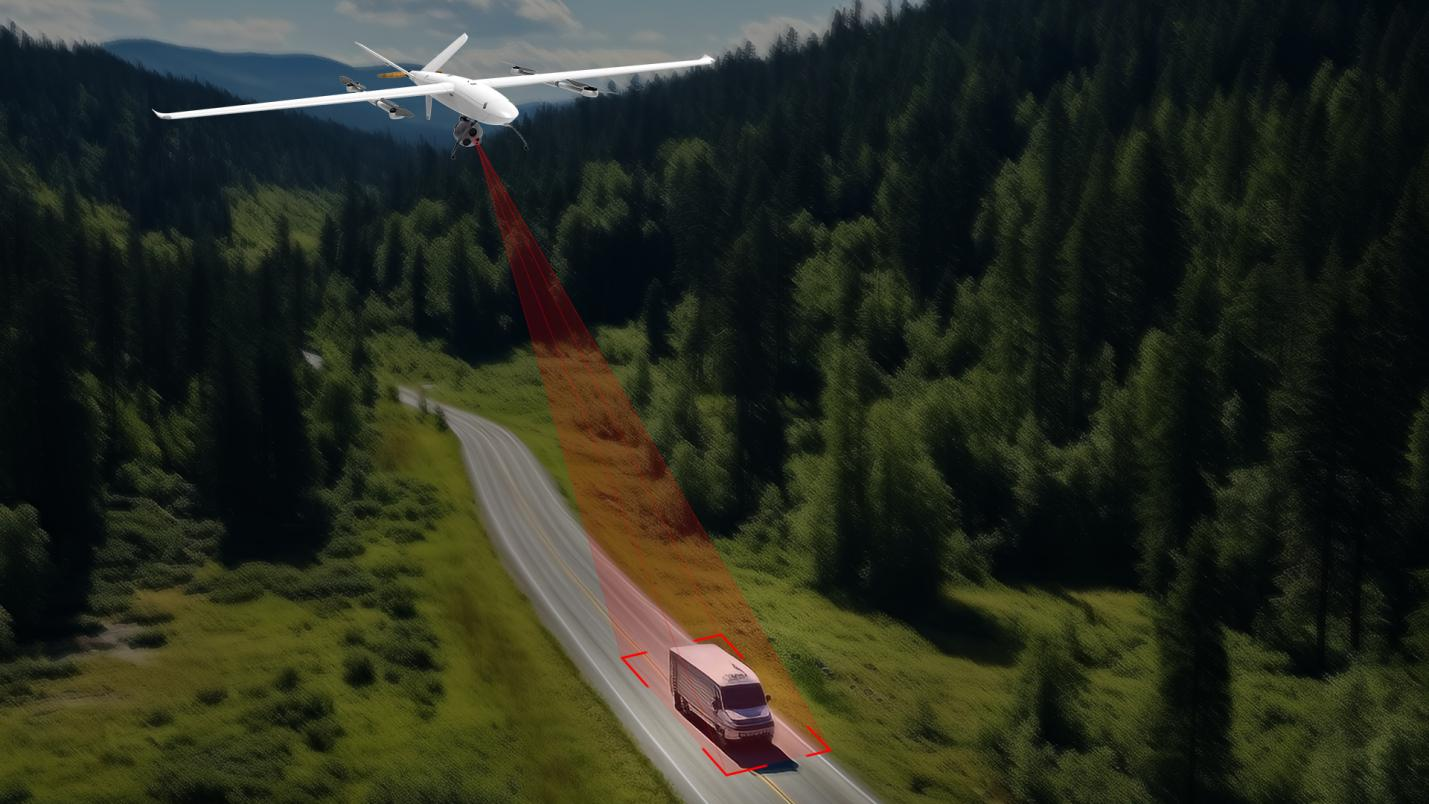
4 Key Advantages of Drone Surveillance Technology
Drone surveillance systems offer significant advantages that traditional security methods can’t match. Drones offer speed, precision, and safety that regular CCTVs cannot.
Faster Threat Detection and Response
One of the most important benefits of UAV surveillance is rapid deployment and response. Drones are capable of patrolling perimeters and wide-open areas 5 to 30 times faster than human or vehicle patrols. With autonomous flight capabilities, you can launch them in seconds. Preparing your crew or warming them up is not needed. That is why they are the best choice for time-sensitive threats or unexpected security breaches.
Enhanced Visual Coverage
With YANGDA’s Sky Whale VTOL drones, you can easily equip your device with advanced EO/IR gimbal cameras to deliver real-time imagery for surveillance, whether it is day or night. Optical zoom allows operators to identify key details like license plate numbers or suspicious packages from a distance. Meanwhile, infrared sensors can detect heat signatures that make it possible to spot intruders, vehicles, or even wildlife hiding under foliage or in darkness. The VTOL drones are reliable no matter what the weather is. Their around-the-clock visibility ensures comprehensive monitoring with little to no blind spots.
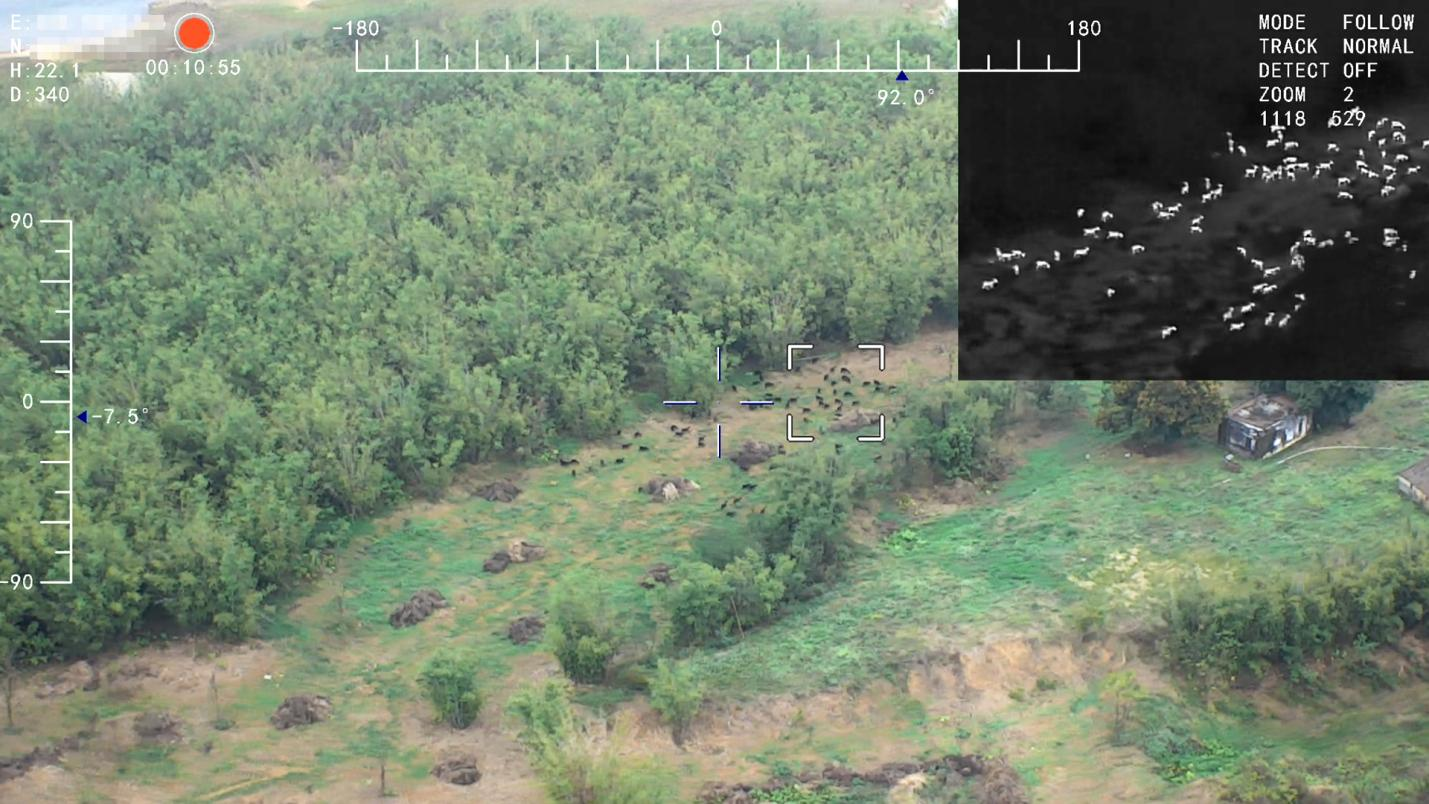
Reduced Risk to Human Operators
Sometimes, places that need security and surveillance are hazardous or have toxic environments. There are times when a place can be prone to hostile intrusions. In these situations, drones can help you assess the area while keeping the security personnel out of harm’s way.
Lower Operational Costs Over Time
The initial investment in drone technology can vary. But one thing is for sure, it saves you more in the long run. With drone technology for security and surveillance, fewer personnel are needed to cover the same ground, which reduces staffing costs. You will also save money on operational expenses, such as vehicle fuel, maintenance, and wear-and-tear costs. Also, drones don’t need permanent towers or physical infrastructure to operate. It helps you avoid paying the high costs of installing and maintaining fixed surveillance systems.
Surveillance Drone Capabilities That Matter
All UAVs are not the same. You must find the right combination of endurance, payload capability, weather-resilience, and autonomous intelligence based on your needs. They must always be available and ready to deploy when you need them.
Long-Endurance Flight
The time your UAV spends in the air is also the time it spends gathering data. That is why endurance is an important factor in selecting a drone for surveillance, especially when you plan to use it for monitoring or patrolling large perimeters and areas.
Advanced electric VTOL drones, such as the YANGDA Sky Whale Mini and Max, can fly for 90 minutes to 4 hours. For missions that require hours of uninterrupted surveillance, hybrid VTOLs like the Sky Whale Max Hybrid can fly up to 10 hours, depending on the payload.
This long airborne duration makes it possible to secure large industrial zones, patrol borders, or conduct overwatch operations without having to swap batteries during operations.
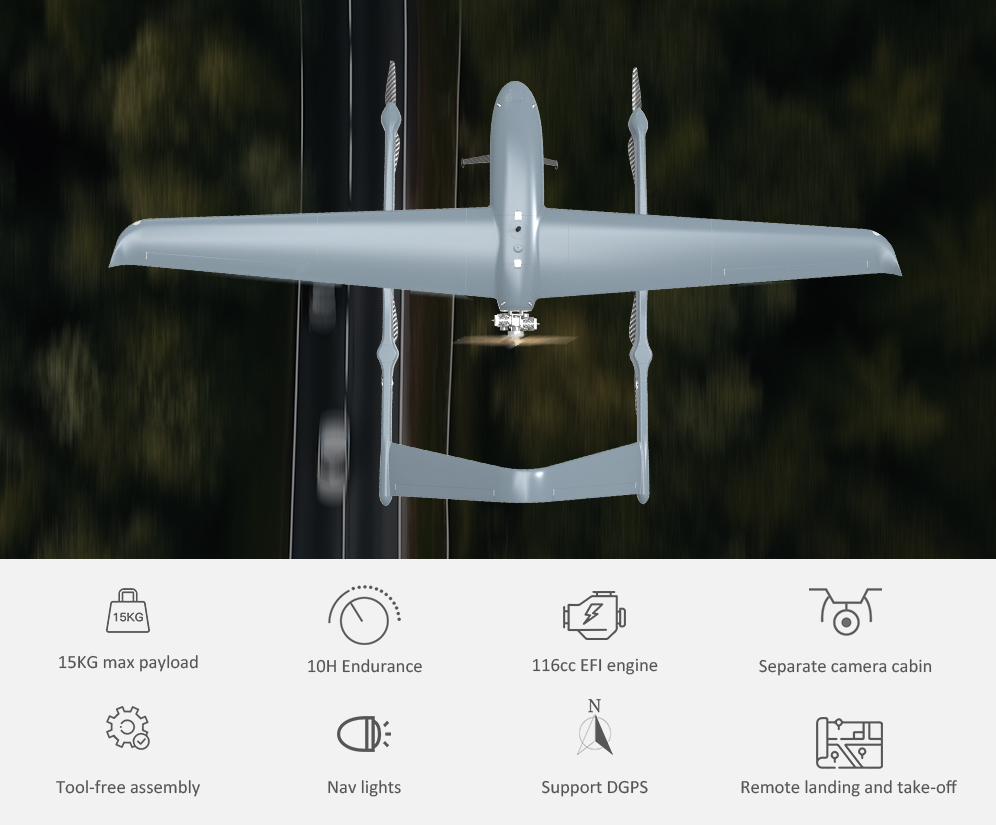
(Model:Sky
Whale Max
Hybrid)
Payload Capacity
The ability to carry advanced sensor systems determines how effective your drone is. Surveillance drones with a payload capacity of up to 2.5 kg can support high-performance EO/IR dual sensor gimbals, such as the Storm Eye-30IE-HT 30X. Having a large payload makes the integration of essential tools easier. With it, you can equip your drone with laser rangefinders for accurate distance measurement, AI-powered vision processors for automated analytics, or even strobe lights.
Autonomous Navigation and AI
The most advanced drones, such as the YANGDA Sky Whale series, don’t need piloting skills. With LAUNCH ground control software, you can operate your drone even as a beginner. By equipping it with a gimbal camera with AI capabilities, you can ensure a smooth operation that only needs minimal human input.
The drones also have a “follow me” feature that lets you track and secure cargo loaded onto a boat or a vehicle. With this feature, the drone is capable of following the flight platform and landing when it completes the task. It is especially useful when you need to track a boat at sea.
The gimbal camera AI-driven features, such as real-time object detection, automated tracking, and visual labeling, allow your drone to identify and monitor threats without waiting for a human operator to track them manually.
Autonomous navigation and AI are essential features a UAV should have. They are important for reducing operator workload and ensuring that sound decisions can be made based on the results the drone has delivered.
Harsh Weather and Night-Time Operation
When it comes to real security, surveillance should not clock out. You should be able to conduct surveillance and security whether the sun is up or not, or whether it is raining or not. That is why one of the most important features a UAV should have is weather resistance.
Surveillance drones are IP-rated. It proves that they can handle missions no matter what the weather is. When you equip them with an EO/IR camera with thermal and infrared imaging, you will get crystal clear visibility at night or in low-light operations.
These features are extremely useful when you are doing surveillance during a storm or tracking intruders undercover at night.
Real-World Applications of Surveillance Drones
Surveillance drones have helped evolve the way security teams, emergency responders, and government agencies protect people, infrastructure, and the environment. Their beginner-friendly flying capabilities, large coverage, and real-time visual intelligence make them indispensable in a growing number of high-stakes scenarios.
Border Surveillance
Drones excel in providing persistent, wide-area surveillance over remote or unguarded border zones. This is where traditional patrols typically fall short. By equipping drones with EO/IR sensors and AI-powered tracking, they can monitor terrain at a distance, detect unauthorized crossings or suspicious activity in real time, and provide live alerts to ground forces for immediate interception or investigation. Drones enhance border security while reducing the need for constant human patrols.
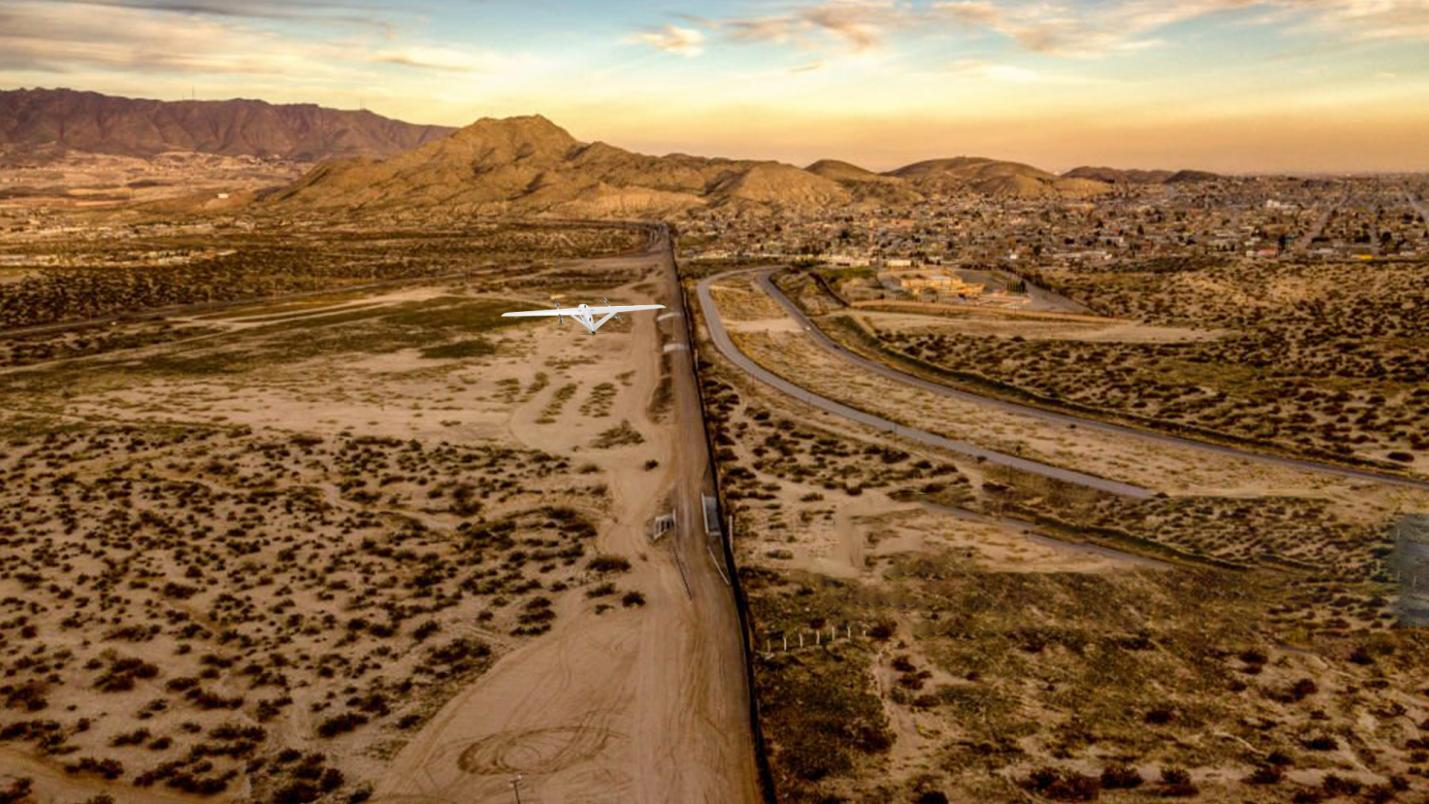
Critical Infrastructure Protection
Critical infrastructure requires constant surveillance to prevent sabotage, theft, or accidental damage. Surveillance drones can help with the routine inspection of infrastructure networks without disrupting operations. They can help deter malicious activity with a visible and mobile aerial presence. They help utility companies and industrial operators reduce downtime, increase safety, and maintain compliance with security regulations.
Anti-Smuggling and Law Enforcement
Speed and visibility are important in law enforcement and customs operations. Surveillance drones can help track vehicles, boats, or individuals attempting to evade detection across land or sea. By equipping the drone with a high-definition gimbal camera, operators in command centers can stream high-definition video directly. It also helps maintain visual contact with the suspect during high-risk pursuits, reducing the need for dangerous ground engagement.
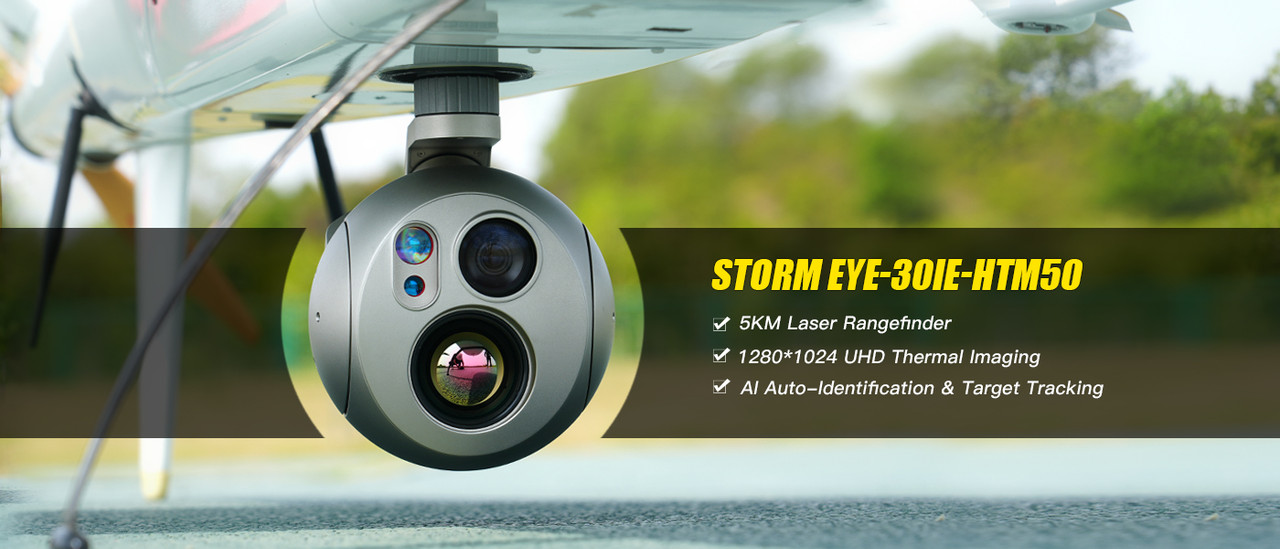
Search and Rescue
Drones can speed up search and rescue missions even at night or in rugged terrain through the use of thermal imaging to detect body heat signatures in dense forests, mountains, or disaster zones. They can follow automated grid search patterns to cover large areas quickly and systematically. They also help relay live imagery to ground teams for faster victim location. Drones have become an important tool for first responders in natural disasters, lost person searches, and humanitarian crises.
Forest Fire Monitoring
Drones can also help firefighters during wildfire outbreaks. Thermal sensors can detect hidden hotspots or flare-ups before they spread. They give commanders a live aerial overview of fire fronts, terrain obstacles, and safe zones. They also support the coordination of the air and ground response teams through real-time visual updates.
Frequently Asked Questions
What is the best drone for 24/7 perimeter security?
For round-the-clock security missions, hybrid VTOL drones like the YANGDA Sky Whale Max Hybrid offer an endurance of up to 10 hours per flight and large payload capacity. When paired with an EO /IR gimbal like the Storm Eye, they deliver continuous surveillance capabilities with minimal downtime between missions. No piloting skills are needed, making them ideal for securing industrial zones, borders, and critical infrastructures.
How far can an EO/IR camera zoom for facial or vehicle ID?
High-performance EO/IR gimbals can offer both high optical zoom and digital zoom, allowing vehicle recognition, including the license plates and model, even from a distance. At night, the infrared sensor enables human and vehicle detection based on heat signatures, through exact identification ranges that depend on resolution, altitude, and environmental conditions.
Yangda gimbal camera features up to 40X optical zoom for the visible light sensor and 8X digital zoom for the thermal imager, enabling detailed observation in various industry applications.
Can these drones fly during rain or at night?
Absolutely. Many surveillance drones are IP-rated for rain and snow. Night operations are supported through thermal imaging and low-light EO cameras, enabling visibility in complete darkness.